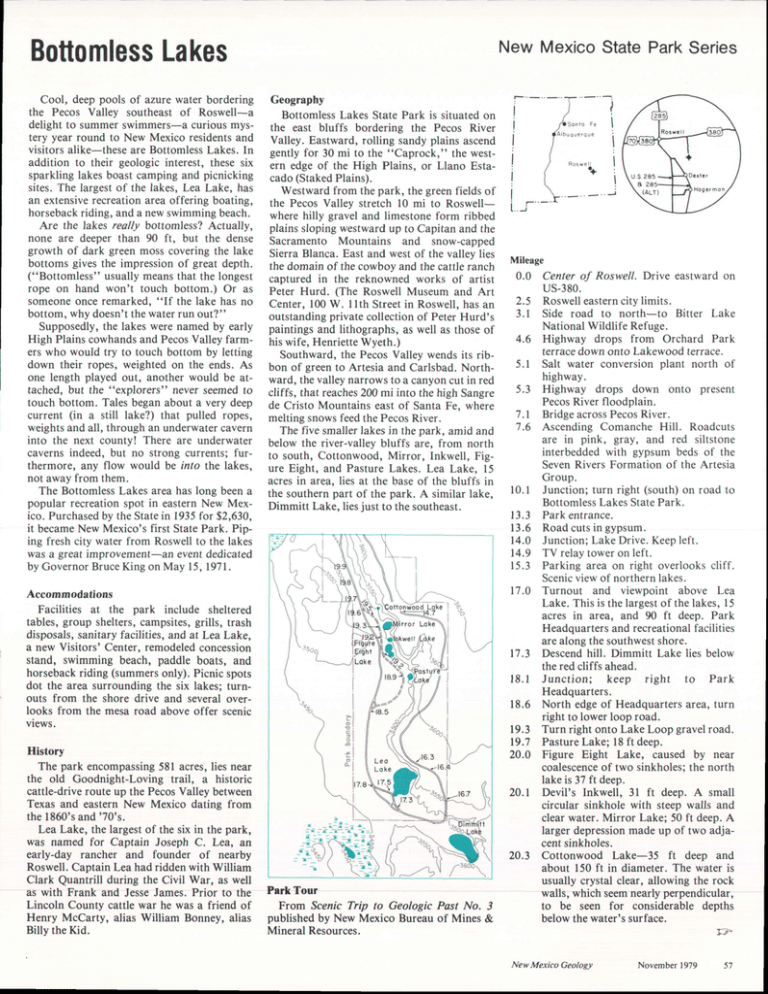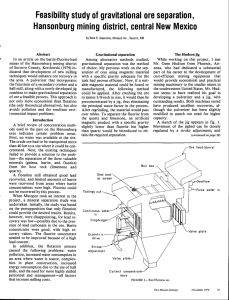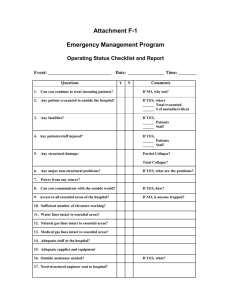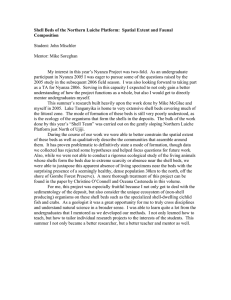Document 11124022
advertisement

20.4 Junctionwith asphaltroad; turn right, go northward. Note sinkholesin vary,. ing stagesof developmentalong bluff to east. 21.0 Lazy Lagoonon left. 22.6 Junctionwith upperroad; end of loop. Turn left to Roswell,13.4mi. Geology The PecosValley near BottomlessLakesis cut in sedimentaryrocks laid down about 230 m.y. (million years)ago in an arm of the vast Permiansea.Periodically,when this areawas a huge, shallowbaylike feature,the gypsum and reddishsiltstonesof the ArtesiaGroup of rocks were deposited.The entire area was tilted very gently (2" to 3o) to the east.The PecosValley was cut during relativelyrecent geologic time in these Permian sediments. Originally, the Pecos River flowed several miles westof Roswell.but the tilt of the beds causedthe river to shift eastwardas downcutting continued. Sedimentsdepositedin the valley by the river are sand,somegravel,and quantitiesof clay and silt. The presentriver channeloccupies the lowest area and is bordered by floodplains with oxbow lakes and swamps marking abandonedchannels(such as Lazy Lagoonin the northwestpart of the park). Abovethe floodplain,especiallyon the west sideof the river, are higherterracescomprised of older sandsand silts.The upperterrace,the Orchard Park, is about 40 ft above the floodplain. The lower terrace, the Lakewood, is about 20 ft abovethe floodplain. Theseterrace sedimentswere depositedand truncated during varying periodsof the Pleistocene Ice Age, 10,000 to 20,000 years ago, as huge volumes of glacier melt-watercame roaring down from the Sangrede CristoMountains. Someof theseArtesia Group rocks are exposedin road cutsalongUS-380at Comanche Hill on the eastsideof the valleybetweenBottomlessLakes StatePark and Roswell.Here the rocks are pink, green,and red siltstones interbeddedwith grayishto white bedsof gypsum. Similar rock beds occur in the park, alongthe roadsand surroundinglakes. A notable feature of these beds are the "PecosDiamonds," small,doubly-terminated quartz crystalsfound for nearly 100mi along the eastsideof the PecosValley, from Dunlap in De BacaCountyto the north, acrossChaves County, to just south of Artesia in Eddy County. In areaswherethe gypsumbedscome to the surface,as at severaloverviewsin the park, the sparkleof sunlightfrom the quartz crystalsis quite noticeable.Gypsum crystals also reflect the sunlight. Perfect quartz crystals are difficu.lt to find, but beautiful PecosDiamondsare prominentin the collectionsof many mineralogists. How did the lakes form? One of the best Gravitational oreseparalion November 1979 New Mexico Geology Flora and fauna Among the vegetationin the valley are mesquite, creosotebush, salt brush, salt grass, snakeweed,salt cedar(tamarisk),yucca,and cactus.Sparsegrassand scatteredshrubsconservethe sandysoil of the uplands. Roadrunners and jackrabbits rule the brush. Rare fish, such as the zebra killifish and Texascyprinodon,inhabit the salty lake waters. D -F. E. Kottlowski NMBM&MR This systemhas the following advantages.l) Powerconsumptionfor processing copperore was 35 percentlessthan a secondarycrusherand a ball mill would haverequired. 2) Capital cost savingsas a result of the elimination of secondary crushing and milling when these operations are combinedinto a singleprocess. 3) Reducedmaintenancecostsdue to reduced wear and lessdown time. 4) Machineoperateson a limited water supply, and at low pollution levels. 5) Minimal skillsarerequiredfor operation. Because these advantages may encourage successfulmining ventures in more remote areas,the developmentof this type of machinery is both economically soundand essential. lcontinuedfrom page55) various water inlets and the overflow, which evacuates air from the pulsewater, allow a very subtle bed movement.The patentedvalve systemregulatesthe suction of the movement.Thesethree variables allow concentration of material down to 325 mesh. In the Hansonburg district, our materialwill be concentrated in threecarefullyscreened groups:50-150 mesh,150-200 mesh,and materialpassing 200mesh. Resultswith the jig have been highly satisfactoryon our ore, with galenaand barite recoverieswell above 90 percent. Fluorspar recovery is somewhat lower (70-80 percent). The remaining tailings will be treated by gravity separation, using magnetic material as previously mentioned.The price of fluorspar at the moment doesnot warrant recoveryfrom the tailings.It will be stockpileduntil better pricesjustify further processing. The pulverizer(fig. 2) is basicallysimilar to any other pulverizer. The most significantdifferenceslie in the designof the breakingplates,the rotor outlet, and the rotor itself. The useof specialwedgeshapedsteelplatesand the curvatureof placesto comprehendtheir origin is at the overlook above Lea Lake where the bluffs coincidewith a sharp flexure in the Artesia Group beds.The regionaldip is gentleand to the east, yet along this river-valleyescarpment, the dip is rather steepto the southwest. The pronouncedreversalof dip is probably due to the solutionof gypsumand consequent slumping of overlying beds. Underground channelsand cavernswere dissolvedout by circulating ground water, resulting in deep, steep-walleddepressionsnow filled by the lakes.'These collapse structurescausedby ground-water solution of rocks are called sinkholes. The lake water, fed from salty underground flow, is high in sulfates(4,000to 14,000ppm) from the gypsumbeds.Thus the necessityof piping in water from Roswell-to make the swimmingmoreenjoyable. Rotor Acknowledgrnents My thanks to Dr. Frank Kottlowski, Director; Robert W. Eveleth, Mining the ore-breakingplates maintain the im- Engineer;and Neila MacDonald, Assopact force perpendicularto the plates, ciateEditor, NM Bureauof Mines& Minthus holding plateswear to a minimum. eral Resources,without whose help this The lid can be lifted hydraulically and paperwould not havebeenpossible. easily swung aside. The ring containing Reference cited the breakingplatescan be removedin 5 minutes;the rotor is similar in design- Kottlowski, F. 8., 19'19,Barite-fluorite-lead mines of the Hansonburg mining district in central New the tungsten-carbideplates are attached Mexico, in New Mexico Geology: NM Bureau of with a few bolts, enablingtheir replace- Mines & Mineral Resources,v. l, no. 2,p.l7-20 _ mentin a matterof minutes. FIGURE 2-Tne pulvsR.rzEn.




